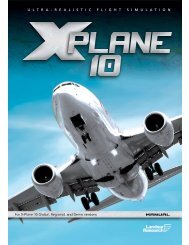Download the Plane Maker Manual - X-Plane
Download the Plane Maker Manual - X-Plane
Download the Plane Maker Manual - X-Plane
You also want an ePaper? Increase the reach of your titles
YUMPU automatically turns print PDFs into web optimized ePapers that Google loves.
88 8. MODIFYING THE APPEARANCE OF AN AIRCRAFT<br />
Figure 8.1: Editing <strong>the</strong> portion of <strong>the</strong> image used to texture <strong>the</strong> left side of <strong>the</strong> fuselage<br />
To create this starting-point texture, open <strong>the</strong> Special menu and click Output Texture Map<br />
Starting Points. This will create one or two PNG files, depending on your use of <strong>the</strong> “use second<br />
texture” checkboxes. For instance, Figure 8.2 shows <strong>the</strong> starting-point image file created for a Van’s<br />
RV-7. If you have not changed <strong>the</strong> locations of your aircraft’s bodies using <strong>the</strong> Visual Texture<br />
Regions, X-<strong>Plane</strong> will use <strong>the</strong> default locations, sizes, and shapes for each of your aircraft’s pieces.<br />
These image file(s) will be saved in your aircraft’s folder with <strong>the</strong> proper names. The first image<br />
(or <strong>the</strong> only one, as <strong>the</strong> case may be) will be called [ACF file name] paint.png. The second image,<br />
where applicable, will be called [ACF file name] paint2.png. Note that in order for <strong>Plane</strong> <strong>Maker</strong><br />
and X-<strong>Plane</strong> to find <strong>the</strong> image textures, <strong>the</strong>y must keep <strong>the</strong>se names.<br />
Note that images used with an aircraft file must have dimensions (in pixels) that are a power of<br />
two. For instance, <strong>the</strong> image could have a resolution of 512 x 2048, 1024 x 1024, 2048 x 1024, and<br />
so on, with a maximum resolution of 2048 x 2048. The files that <strong>Plane</strong> <strong>Maker</strong> outputs will abide<br />
by <strong>the</strong>se rules.<br />
Using <strong>the</strong> starting-point images from <strong>Plane</strong> <strong>Maker</strong>, you can create painted or photo-realistic<br />
textures. After modifying <strong>the</strong> image files, open <strong>the</strong> Special menu and click Reload Textures (or<br />
press <strong>the</strong> T key) to refresh <strong>the</strong> textures from your files.<br />
For a step-by-step guide to creating a simple photo-realistic texture, see this tutorial on <strong>the</strong><br />
X-<strong>Plane</strong> Wiki.<br />
Fine-Tuning a Paint Job<br />
As discussed in <strong>the</strong> section above, <strong>the</strong> Visual Texture Regions dialog box can be used to modify<br />
<strong>the</strong> portion of your texture image used for each part of <strong>the</strong> aircraft. Modifying <strong>the</strong>se regions using<br />
<strong>the</strong> mouse, however, will always be limited in precision.














